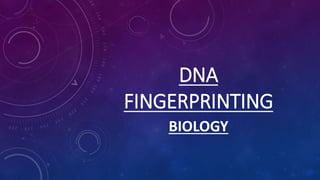
DNA Fingerprinting Biology Class12.pptx
- 2. WHAT IS DNA FINGERPRINTING? DNA Fingerprinting is a way to identify a certain individual, rather than simply identifying a species or a particular trait. A technique used by scientists to distinguish between individuals of the same species using only samples of their DNA.
- 3. WHO DISCOVERED IT? Sir Alec John Jeffreys, CH FRS MAE (born 9 January 1950) is a British geneticist known for developing techniques for genetic fingerprinting and DNA profiling which are now used worldwide in forensic science to assist police detective work and to resolve paternity and immigration disputes.He is Professor of Genetics at the University of Leicester, and he became an honorary freeman of the City of Leicester on 26 November 1992. In 1994, he was knighted for services to genetics.
- 4. 6 STEPS TO DNA FINGERPRINTING Step 1: Isolation of DNA: DNA must be recovered from cells or tissue. Only a small amount of blood, hair, or skin is needed. Step 2: Cutting, Sizing, and Sorting: Restriction enzymes are used to cut the DNA at specific places. In a process called electrophoresis, DNA pieces are sorted out by their size. Then the DNA pieces are passed through a gel made of seaweed agarose
- 5. 6 STEPS TO DNA FINGERPRINTING Step 3: Transfer of DNA to Nylon: The DNA pieces are transferred to a nylon sheet by placing the sheet on the gel and soaking them overnight. Step 4-5: Probing: Adding radioactive or colored probes to the nylon sheet produces a pattern, which is the DNA Fingerprint. Each probe only sticks to one or two specific places on the sheet. Step 6: DNA Fingerprint: The final DNA fingerprint is built by using several probes. It resembles bar codes.
- 6. USES OF DNA FINGERPRINTING DNA fingerprinting most often has been used in court cases and legal matters. It can: Physically connect a piece of evidence to a person or rule out someone as a suspect. Show who your parents, siblings, and other relatives may be. Identify a dead body that’s too old or damaged to be recognizable. DNA fingerprinting is extremely accurate. Most countries now keep DNA records on file in much the same way police keep copies of actual fingerprints. It also has medical uses. It can: Match tissues of organ donors with those of people who need transplants. Identify diseases that are passed down through your family. Help find cures for those diseases, called hereditary conditions. Fingerprint Test To get your DNA fingerprint, you would give a sample of cells from your body. This can come from a swab inside your mouth, from your skin, the roots of your hair, or your saliva, sweat, or other body fluids. Blood is usually the easiest way. Lab workers treat the sample with chemicals to separate the DNA, which is then dissolved in water.
- 8. THANK YOU MADE BY LAKSHITA KUMARI CLASS: XI-B ROLL NUMBER: 11 SUBJECT: BIOLOGY